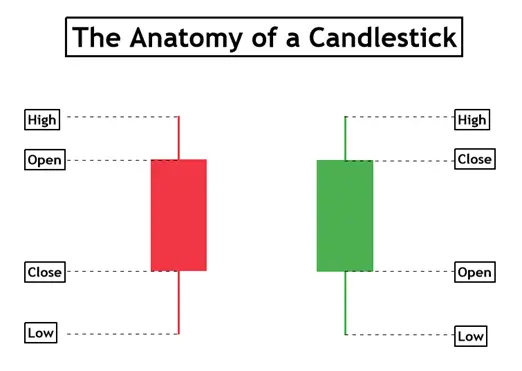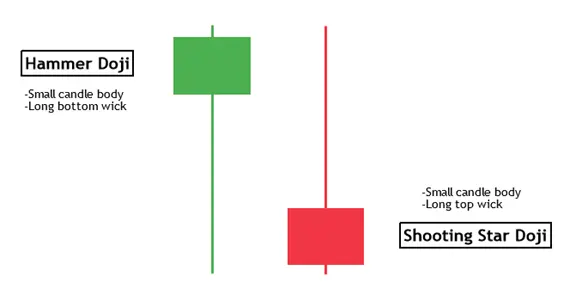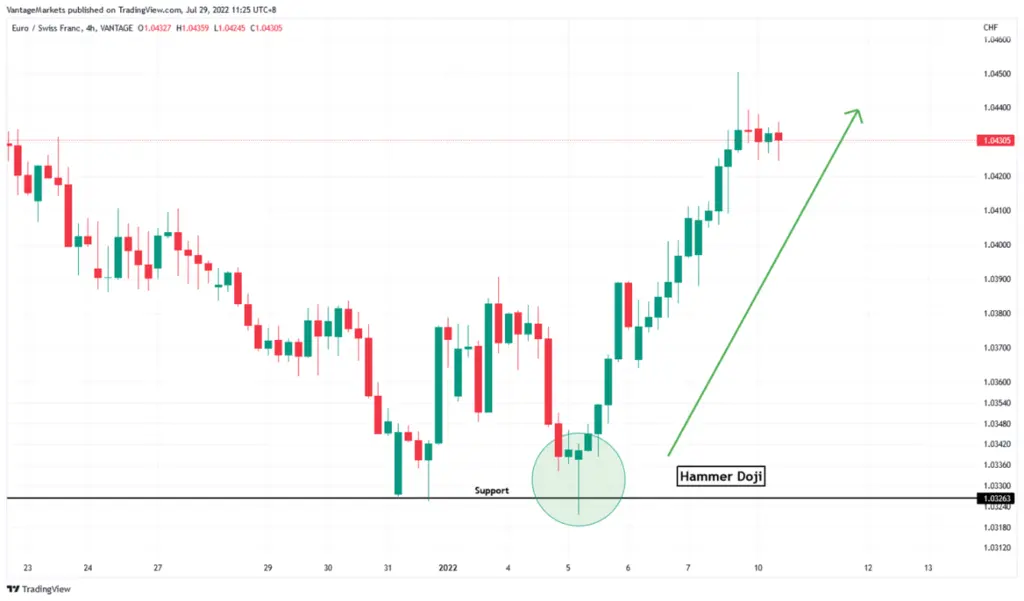What Are Candlesticks?
Candlesticks provide a wealth of information for a trader to understand about a certain asset class. Within a candlestick, there are four pieces of information a trader can derive from.
- Open
- Close
- High
- Low

On the daily chart, each candle represents 24 hours’ worth of information. When looking at one daily candle, the candle’s open and close represents the price of that asset when market opens (12AM) and the price of that same asset when market closes (11 PM). The high and low represents the highest and lowest price of that asset within the 24 hours.
An additional point to note is the color of the candle. A green (bullish candle) means that asset class closed higher than its opening price. A red (bearish) candle means that the close is lower than its opening price.
With all this information derived from one humble candlestick, do not underestimate the value of using candlesticks in your trading as each candlestick tells a certain story.
Why Use Candlesticks?
If a singular candlestick can provide so much information, imagine a group of them together. A group of candlesticks together form critical patterns that traders use to make trading decisions. Simple candlestick patterns can involve one or two candles while more complex patterns involve three.
Ready to start trading with candlestick analysis? Open a live account with Vantage today and unlock the potential of these market indicators.
How reliable are candlestick patterns?
Steve Nison also known as Mr. Candlestick, was the individual who highlighted the value of candlesticks to the west by learning it from a Japanese broker. After, he studied and wrote books revolving around this topic, and candlesticks ultimately gained popularity in the 1990s [1].
Since then, candlestick have become widely discussed and candlestick patterns began to form. The reliability of the candlesticks has also slowly been improving. However, it is most useful when used in tandem with other technical analysis techniques.
Types of Candlestick Patterns
No matter what candlestick pattern a trader uses, it is always best to use it in conjunction with other tools. For the case studies below, the candlestick patterns will be used in tandem with the concept of support and resistance.
Famous One-Candlestick Patterns – Hammer & Shooting Star Doji
In this segment, one candle stick pattern will be the focus. Note the common characteristic of both the shooting star and the hammer is that the candles have a prominent wick and relatively small candle body.
Both patterns serve to illustrate market indecision and hint a potential reversal in the market.

(Case Study 1 – Hammer Doji)

In figure 3, the formation of the Hammer Doji at a support level provides the trader with insight that markets could turn from bearish to bullish.
(Case Study 2 – Shooting Star Doji)
Figure 4 depicts a Shooting Star Doji forming at a critical resistance level. This should hint a trader that markets could turn from bullish to bearish.
Famous Two-Candlestick Patterns – Bullish & Bearish Engulfing
Engulfing patterns involve two candlesticks of opposite colours. The second candle’s body must be bigger than the first candle; hence the term “engulfing”. Through this simple two candled pattern, traders can then make trading decisions. Bullish and bearish engulfing patterns are popular because they can be spotted easily and traded. When such patterns occur at a bottom or the top of a trend, it signals a potential reversal.
(Case Study 3 – Bullish Engulfing)
Figure 6 shows the bullish engulfing pattern in action. At a significant support, a bullish engulfing on EURGBP led to shift from bearish to bullish market structure.
(Case Study 4 – Bearish Engulfing)
In figure 7, a prominent resistance can be seen and at the 3rd tap of the resistance line, market prints a bearish engulfing pattern. What follows suit is a strong bearish push to the downside.
Famous Three-Candlestick Patterns – 3 white soldiers & 3 black crows
Three candlesticks are the maximum number for a candlestick pattern, also providing the most information and confirmation compared to the Dojis and Engulfings.
(Case Study 5 – 3 White Knights)
Figure 9 shows the 3-White Knight pattern forming at support. The three candles involved progressively gets larger, signifying a possible emergence of a bull market.
(Case Study 6 – 3 Black Crows)
The formation of 3-Black Crows at a resistance in figure 10 highlights a high possibility of a incoming bearish market.
Sumamry of Candlestick Patterns
Table 1 showcases the basic characteristics of each candlestick pattern and the expected market direction after the pattern has occurred.
| Pattern | Characteristic | Market direction after |
| Hammer | One candle patternSmall bullish body with long bottom wickAppears at support | Bullish |
| Shooting Star | One candle patternSmall bearish body with long top wickAppears at resistance | Bearish |
| Bullish Engulfing | Two candle patternsSecond bullish candle body engulfs first candle bodyAppears at support | Bullish |
| Bearish Engulfing | Two candle patternsSecond bearish candle body engulfs first candle bodyAppears at resistance | Bearish |
| Three White Soldiers | Three candle patternsAll three candles are bullishCandle body size increasesAppears at support | Bullish |
| Three Black Crows | Three candle patternsAll three candles are bearishCandle body size increasesAppears at resistance | Bearish |
Candlestick Pattern Tools
Apart from the patterns mentioned, there are other candlestick patterns that may be of tremendous use for a trader.
- (Vantage’s Indicator – Adaptive Candlesticks)
Candlestick patterns that illustrate important changes in supply and demand, the Adaptive Candlesticks scans for 16 trusted candlestick patterns on any chart. A combination of unique technical and quantitative analysis helps the trader to make decision based on current context.
- (Vantage’s Protrader Tools – Technical Insights)
The Technical Insights function offered by Vantage Protrader Tools highlights key price action patterns on major & minor Forex pairs, and commodities.
Want to have access to advanced candlestick patterns at your fingertips? Sign up for Vantage Live Account!
Conclusion
Candlestick patterns have withstood the test of time and have proved to be effective in financial trading. However, such patterns appear more frequently than not and should be used in conjunction with other technical concepts such as support & resistance. Want to practice trading candlestick patterns? Sign up for your own Forex Demo Account and try it out now!
References
- BabyPips.com. (2022, July 29). What is a Japanese Candlestick in Forex Trading? https://www.babypips.com/learn/forex/what-is-a-japanese-candlestick



